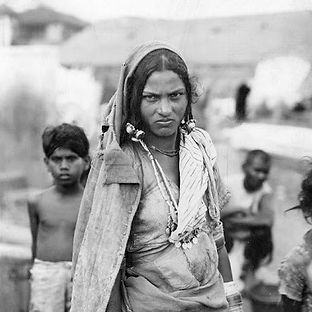top of page

CASTE-BASED DISCRIMINATION
1500 BCE
Despite having been formally abolished in the 1950s in India, discrimination based on the ancient South Asian caste system still persists in practice. While the origins of this hierarchical system are not fully known, the castes seem to date back thousands of years with the arrival of the ancient Aryans. This nomadic group of people had migrated into the Indian subcontinent around 1500 BCE, bringing with them an already-established caste system with four main categories, or varnas: Brahmins (priests and teachers), Kshatriyas (warriors and aristocrats), Vaishyas (merchants and traders), and Shudras (laborers)—all of which are designated at birth. The separation of people began to take hold with the popularization of Hinduism—initially a tradition started within the Brahmin class. Hindu ideals of karma and reincarnation had led the people to believe that Shudras were born into their caste due to misdeeds in their previous life.
Dalits, or “untouchables,” form a fifth group that do not fall within the caste system—outcasts, in every sense of the word. Considered impure from birth and falling in the lowest stratum of society, Dalits are subject to discrimination, stigma, marginalization, and violence. Dalit women are frequent victims of sexual abuse. While socioeconomic, educational, and legal interventions have been made in favor of Dalits, many of them continue to face undue discrimination and prejudice in the workplace, school, and various other settings—even in the United States.









ADDITIONAL RESOURCES
Ishisaka, N. (2023). How India's caste system manifests in Seattle-area workplaces and beyond. The Seattle Times. https://www.seattletimes.com/seattle-news/how-indias-caste-system-manifests-in-seattle-area-workplaces-and-beyond/
Iyer, P. (2016). Emotions and Discrimination in Caste Conflicts. Peace Review (Palo Alto, Calif.), 28(4), 466–473. https://doi.org/10.1080/10402659.2016.1237104
Mayell, H. (2003). India's "Untouchables" Face Violence, Discrimination. National Geographic. https://www.nationalgeographic.com/pages/article/indias-untouchables-face-violence-discrimination
Pariyar, P., Gupta, B., & Fonseka, R. W. (2022). “When I tell them my caste, silence descends”: Caste-based Discrimination among the Nepali Diaspora in the San Francisco Bay Area, USA. CASTE: A Global Journal on Social Exclusion, 3(1), 189–202. https://www.jstor.org/stable/48674180
Thapa, R., van Teijlingen, E., Regmi, P. R., & Heaslip, V. (2021). Caste Exclusion and Health Discrimination in South Asia: A Systematic Review. Asia Pacific Journal of Public Health, 33(8), 828–838. https://doi.org/10.1177/10105395211014648
Wilkerson, I. (2020). American's Enduring Caste System. The New York Times Magazine. https://law.indiana.edu/publications/faculty/2020/dau-schmidt-caste-system-nyt.pdf
Wilkerson, I. (2020). America's 'untouchables': The silent power of the caste system. The Guardian. https://www.theguardian.com/world/2020/jul/28/untouchables-caste-system-us-race-martin-luther-king-india
TIMELINE OF EVENTS
CLICK ON AN EVENT ABOVE TO LEARN MORE...
bottom of page













